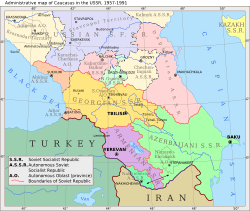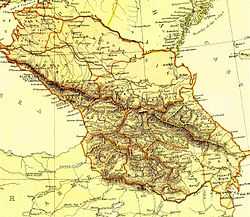History of the Caucasus

One can divide the history of the Caucasus region into the history of the Northern Caucasus (Ciscaucasia), historically in the sphere of influence of Scythia and of Southern Russia (Eastern Europe), and that of the Southern Caucasus (Transcaucasia; Caucasian Albania, Georgia, Armenia), in the sphere of influence of Persia, Anatolia and Assyria.
In modern times, the Southern Caucasus and a part of the Northern Caucasus (Dagestan) formed part of the Persian Empire, while the Russian Empire conquered and annexed the Northern Caucasus in the course of the 19th century in the Caucasian Wars (1817-1864). In 1813 and 1828 by the Treaty of Gulistan and the Treaty of Turkmenchay, the Persians conceded sovereignty over the Southern Caucasus and Dagestan to Russia.[1]
The Northern Caucasus became the scene of intense fighting during the Second World War. Nazi Germany attempted to capture the Caucasus region from Soviet control in 1942 by a two-pronged attack towards both the western bank of the Volga (intending to seize the city of Stalingrad) and by a drive southeast towards Baku, a major center of oil production. The Nazis intended to establish a Reichskommissariat Kaukasus to control the Caucasian territories of the Soviet Union. Considerable parts of the northern Caucasus fell under German occupation, but the invasion eventually faltered as it failed to accomplish either goal, and Soviet soldiers drove the Germans back west following the Battle of Stalingrad (1942-1943).
Following the dissolution of the Soviet Union, Armenia, Azerbaijan, and Georgia all became independent in 1991. The Caucasus region has become the setting for various territorial disputes in the present day, leading to the Nagorno-Karabakh War (1988–1994), the Ossetian-Ingush conflict (1989–1991), the War in Abkhazia (1992–1993), the First Chechen War (1994–1996), and the Second Chechen War (1999–2009).
Prehistory
Stone Age
- Metsamor site
- Shulaveri-Shomu culture
- Nakh peoples
Bronze Age
- Maykop culture
- Leyla-Tepe culture
- Kura-Araxes culture
- Trialeti culture
- Jar-Burial Culture
- Kurgan culture
- Nakh peoples
Iron Age
- Khojaly-Gadabay culture (c. 1300 - 600 BC)
- Colchian culture (c. 1200 - 600 BC)
- Koban culture (c. 1100 - 400 BC)
- Urartu (c. 860 - 590 BC)
- Nakh peoples
- Assyrian empire (c. 934 BC - 609 BC)
Classical Antiquity

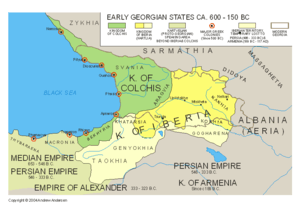
- Caucasian Albania
- Caucasian Iberia
- Colchis
- Mushki
- Persia
- Media (728 BC – 549 BC)
- Achaemenid Empire (c. 550 BC – 330 BC)
- Parthia (247 BC – AD 224)
- Sassanid Empire (224–651)
- Kingdom of Armenia
-

Ancient countries of the Caucasus - Armenia, Colchis, Iberia and Albania
-
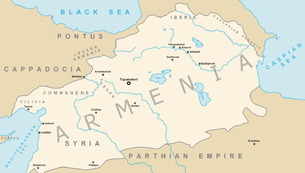
Greatest extent of Kingdom of Armenia under Tigranes the Great
Middle Ages
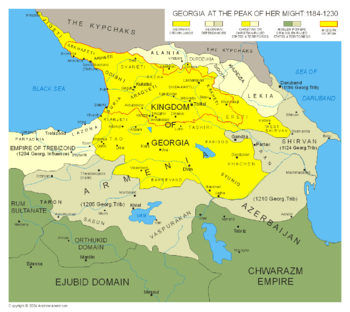
- Byzantine Empire (330–1453)
- Khazars
- Arab Caliphate
- Rashidun Caliphate (632–661)
- Umayyad Caliphate (661–750)
- Abbasid Caliphate (750–1258)
- Persia
- Kingdom of Armenia (Middle Ages)
- Seljuq dynasty (1037–1194)
- Ilkhanate (1256–1335)
- Kingdom of Georgia
Modern history

- Persia
- Timurid dynasty (1370–1526)
- Safavid dynasty (1501–1736)
- Afsharid dynasty (1736–1796)
- Zand dynasty (1750–1794)
- Qajar dynasty (1794–1925)
- Ottoman Empire
- Karabakh Khanate
- Russian Empire
- Russian Civil War
- Ethnic cleansing of Circassians
- Transcaucasian Democratic Federative Republic
- Soviet Union
- Nagorno-Karabakh War (1988–1994)
- Ossetian-Ingush conflict (1989–1991)
- Chechen Republic of Ichkeria (1991–2000)
- Republic of Georgia (since 1991)
- Republic of Armenia (since 1991)
- War in Abkhazia (1992–1993)
- First Chechen War, 1994–1996
- Second Chechen War, 1999–2006
- 2008 South Ossetia war, 2008
See also
- Caucasus Greeks
- North Caucasus
- South Caucasus
- History of Georgia (country)
- History of Armenia
- History of Azerbaijan
- History of Abkhazia
- History of Chechnya
- History of Nagorno-Karabakh
- History of Nakhchivan
- Southern Russia
- Eastern Magyars
Further reading
- Asmus, Ronald. A Little War that Shook the World : Georgia, Russia, and the Future of the West. NYU (2010). ISBN 978-0-230-61773-5
- de Waal, Thomas. Black Garden. NYU (2003). ISBN 0-8147-1945-7
- Gasimov, Zaur: "The Caucasus", European History Online, Mainz: Institute of European History, 2011, retrieved: November 18, 2011.
- Goltz, Thomas. Azerbaijan Diary : A Rogue Reporter's Adventures in an Oil-Rich, War-Torn, Post-Soviet Republic. M E Sharpe (1998). ISBN 0-7656-0244-X
- Goltz, Thomas. Chechnya Diary : A War Correspondent's Story of Surviving the War in Chechnya. M E Sharpe (2003). ISBN 0-312-268-74-2
- Goltz, Thomas. Georgia Diary : A Chronicle of War and Political Chaos in the Post-Soviet Caucasus. Thomas Dunne Books (2003). ISBN 0-7656-1710-2
- Shapi, Kaziev. Caucasian highlanders (Повседневная жизнь горцев Cеверного Кавказа в XIX в.). Everyday life of the Caucasian highlanders. 19th century (In the co-authorship with I.Karpeev). "Molodaya Gvardiy" publishers. Moscow, 2003. ISBN 5-235-02585-7
References
| ||||||||||
